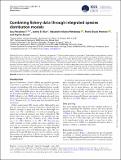Combining fishery data through integrated species distribution models
Abstract
Species Distribution Models are pivotal for fisheries management. There has been an increasing number of fishery data sources available, making data integration an attractive way to improve model predictions. A wide range of methods have been applied to integrate different datasets in different disciplines. We focus on the use of Integrated Species Distribution Models (ISDMs) due to their capacity to formally accommodate different types of data and scale proportional gear efficiencies. ISDMs use joint modelling to integrate information from different data sources to improve parameter estimation by fitting shared environmental, temporal and spatial effects. We illustrate this method first using a simulated example, and then apply it to a case study that combines data coming from a fishery-independent trawl survey and a fishery-dependent trammel net observations on Solea solea. We explore the sensitivity of model outputs to several weightings for the commercial data and also compare integrated model results with ensemble modelling to combine population trends in the case study. We obtain similar results but discuss that ensemble modelling requires both response variables and link functions to be the same across models. We conclude by discussing the flexibility and requirements of ISDMs to formally combine different fishery datasets.
Citation
Paradinas , I , Illian , J B , Alonso-Fernändez , A , Pennino , M G & Smout , S 2023 , ' Combining fishery data through integrated species distribution models ' , ICES Journal of Marine Science , vol. 80 , no. 10 , pp. 2579-2590 . https://doi.org/10.1093/icesjms/fsad069
Publication
ICES Journal of Marine Science
Status
Peer reviewed
ISSN
1054-3139Type
Journal article
Description
Funding: IP would like to thank the European Commission for the funding (GAP-847014). IP is grateful to the MSCA fellowship that supported his research. MGP thanks the project IMPRESS (RTI2018-099868-B-I00), ERDF, Ministry of Science, Innovation, and Universities - State Research Agency.Collections
Items in the St Andrews Research Repository are protected by copyright, with all rights reserved, unless otherwise indicated.

